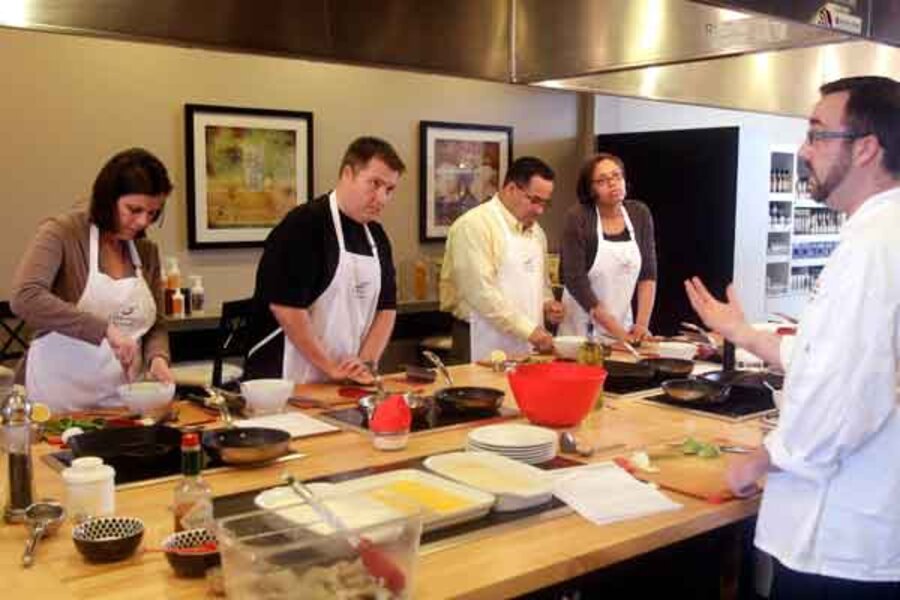Foodie nation: Why we're in the kitchen
If you are a fan of old houses, you’ve probably noticed that in most of them the original kitchen was no great shakes, especially compared with the dining room. Dining rooms were shrines to decorum. Kitchens were to be neither seen nor smelled.
Even in the grand houses of Newport, R.I., where few rooms escaped gilding or marblizing, most kitchens were just a step up from garages. They were workshops where menial, hot, smoky, messy, and sometimes dangerous processes took place. Blood was let, fat was rendered, bones were boiled.
No one in the 19th century and the first half of the 20th would have thought of inviting guests into a kitchen to help slice zucchini or stir a roux while ogling the stainless steel appliances and nibbling on cheese. Food prep was done behind the scenes. Grazing was for livestock. Butcher block wasn’t a countertop choice.
Dining and cooking were barely connected. Dining was a time for dressing up, sitting down, clinking glasses, and gracefully shifting conversational partners between courses. The 19th-century French gourmand Jean Anthelme Brillat-Savarin called dining “one of the principal bonds of society.” Though he occasionally amused his guests by whipping up a souffle at the sideboard, he seldom went beyond partaking of what his cook prepared.
Noting the difference between mere eating and dining, Mr. Brillat-Savarin (who, by the way, has a wonderful cheese named after him) observed that when “hunger begins to be satisfied, reflection begins, and conversation commences. The person who, hitherto, had been a mere consumer, becomes an amiable guest.”
No use lamenting that lost world. The modern kitchen, built for a more egalitarian age, is here to stay. Vent hoods got rid of the smoke and smell. Plumbing and electricity boosted cleanliness and convenience. Shelter magazines encouraged people to class up their act. And D.I.Y. stores learned to lift large sums of money from our wallets to fund the arms race in cabinets, countertops, and other dazzlements.
You could feel the joy of food movement beginning as far back as the 1960s. Back then, as the Monitor’s long-time food writer, John Young, recalls, everybody seemed to graduate at once from TV dinners to home-made lasagne. Layering meat, cheese, and tomato sauce onto big squares of pasta wasn’t rocket science.
“You’d always hear them say, ‘Oh, but you haven’t tasted my lasagne,’” says John. “But their lasagne was just like everybody’s lasagne.”
Still, it was a start. The foodie nation (which Kendra Nordin describes in this special report) sees food as art and kitchen as stage. And yet unlike music or painting or acting, cooking doesn’t require genius or endless practice. Any amateur can do it.
Upstream factories take care of the dirty work of slaughtering, skinning, and cleaning. Supermarkets present everything in pretty packages. Farmers’ markets provide a virtuous dash of localness. Google delivers precise recipes. With timers and microprocessors, it’s hard to mess up.
Food culture has moved well beyond lasagne. Not only are there legions of celebrity chefs and wannabes, even food bloggers are becoming famous. See the charming 2009 movie “Julie & Julia” and note that Sony Pictures has optioned “Black Heels to Tractor Wheels” from the wildly popular Pioneer Woman blogger.
“Stir it Up!” the CSMonitor.com blog collection that Kendra manages, features the work of 17 such bloggers. Their stylings range from accessible (minted lemonade) to adventurous (olive oil gelato). One blogger, Megan Fizell from Australia, deconstructs fine art into recipes. Shane Kearns specializes in grilled cheese sandwiches. Amy Deline, “The Gourmand Mom,” posts simple recipes that a mom with small children can concoct.
The point is that you don’t have to worry about the heat anymore. Which is why we're all in the kitchen.
John Yemma is the editor of The Christian Science Monitor.





